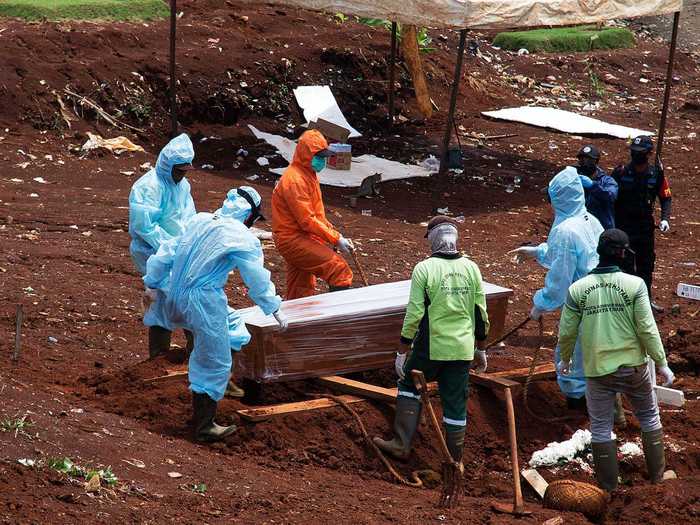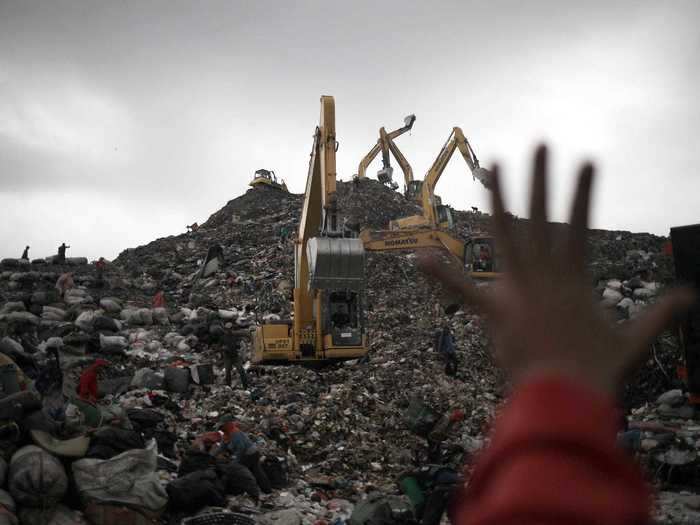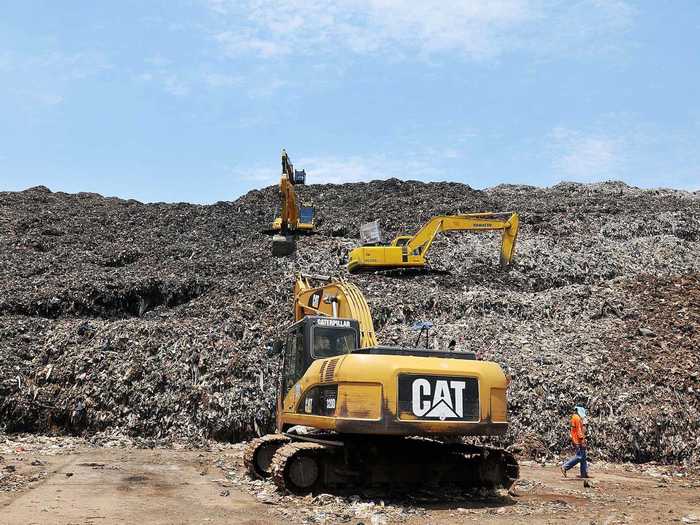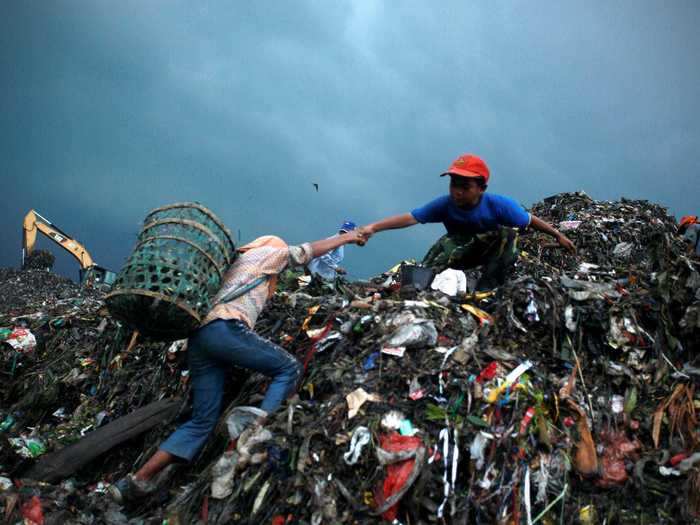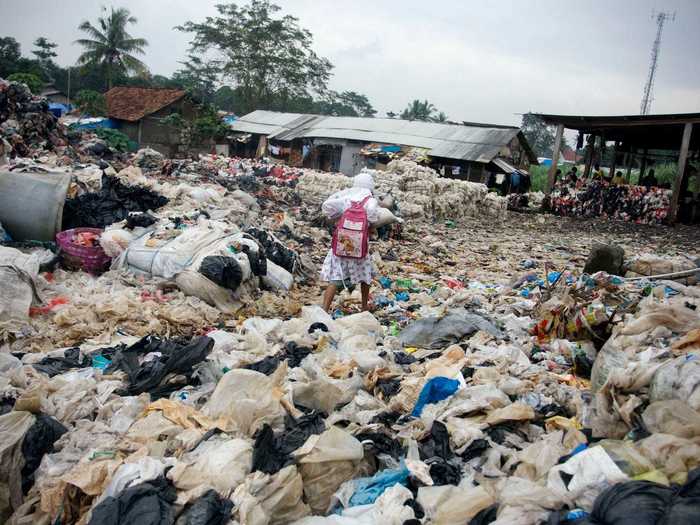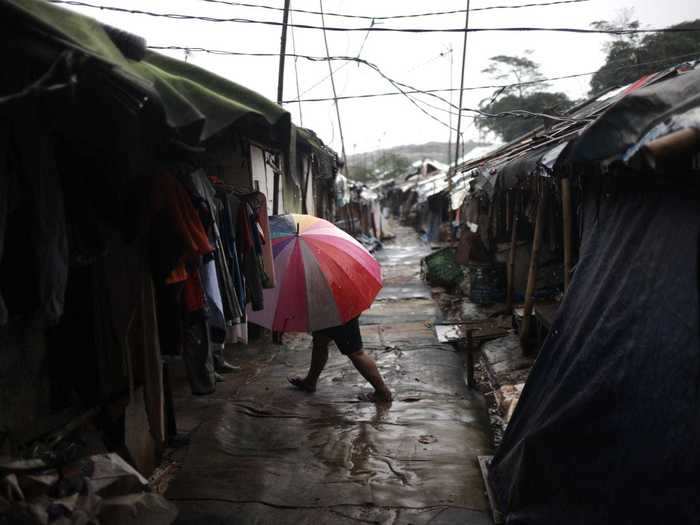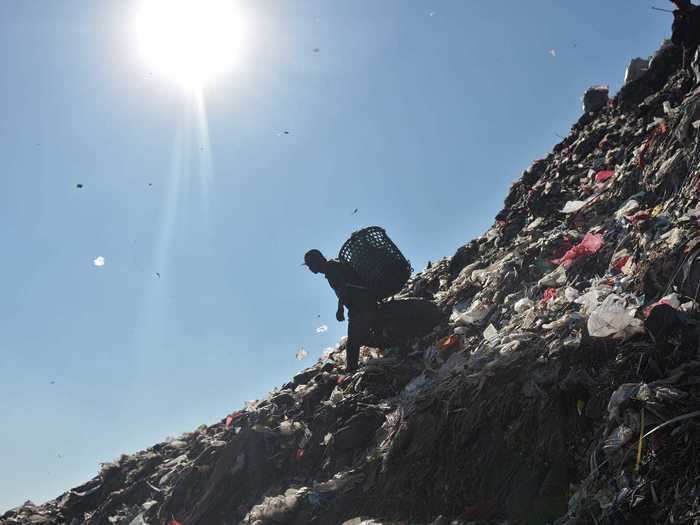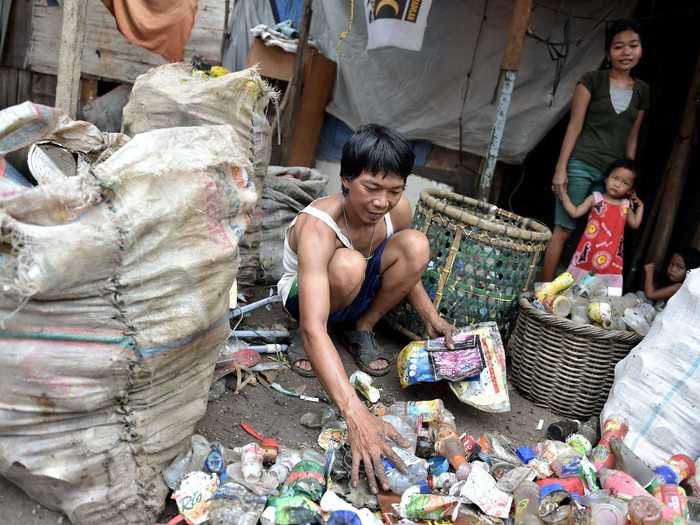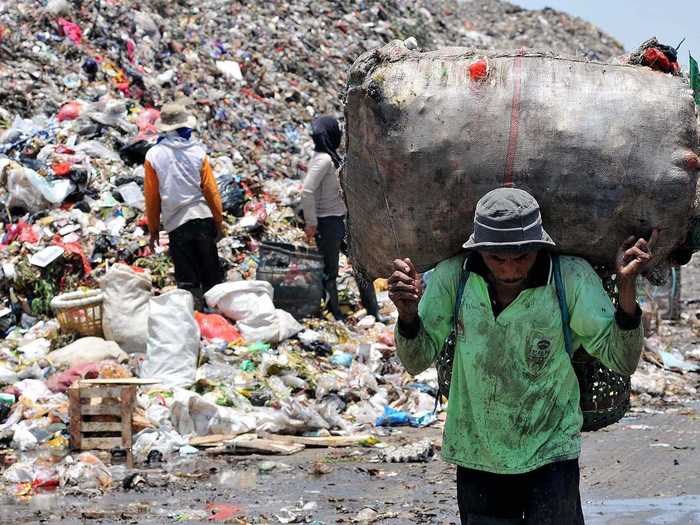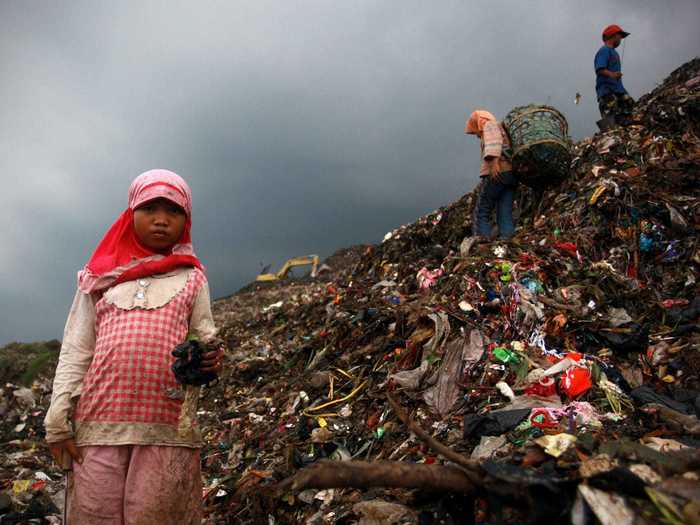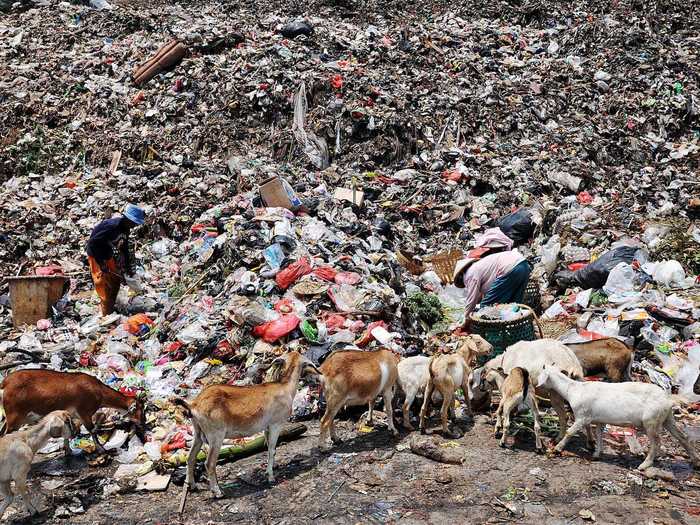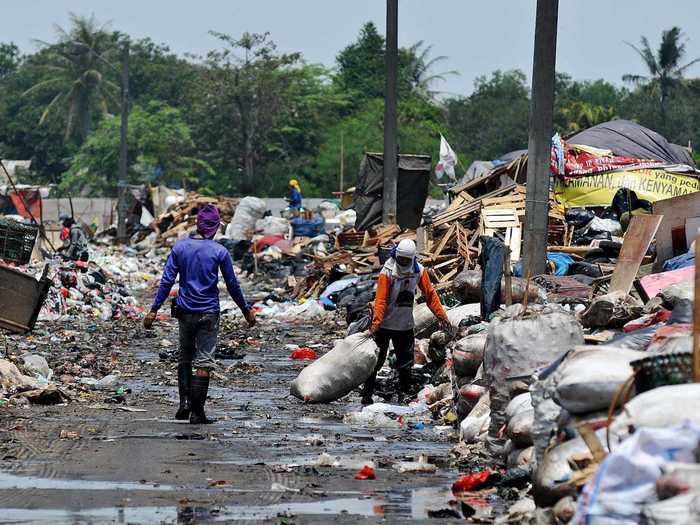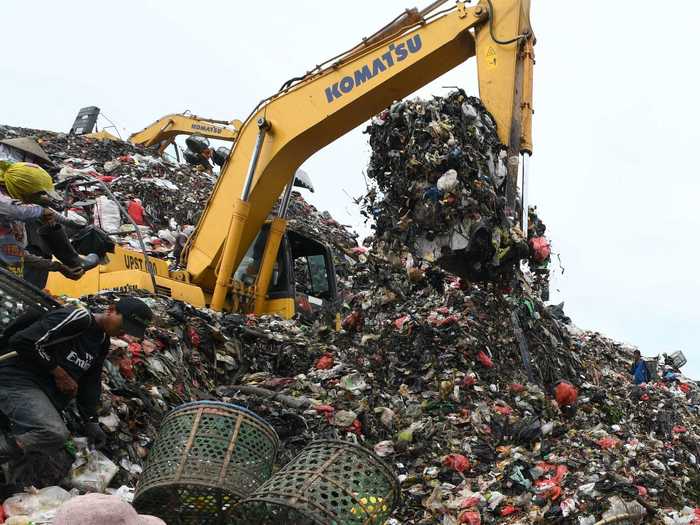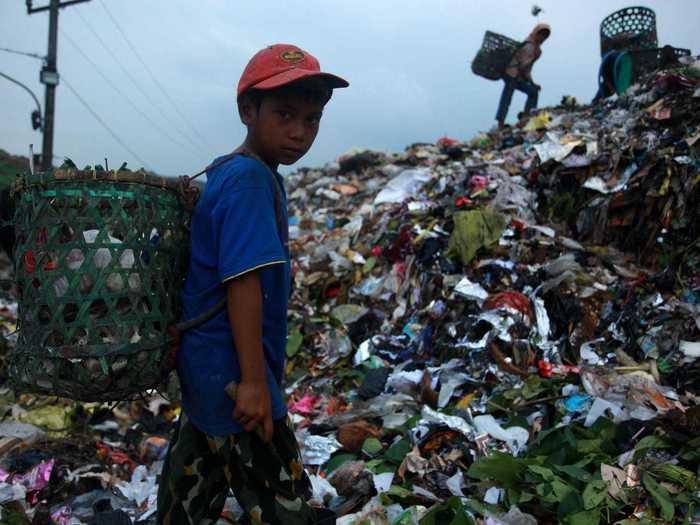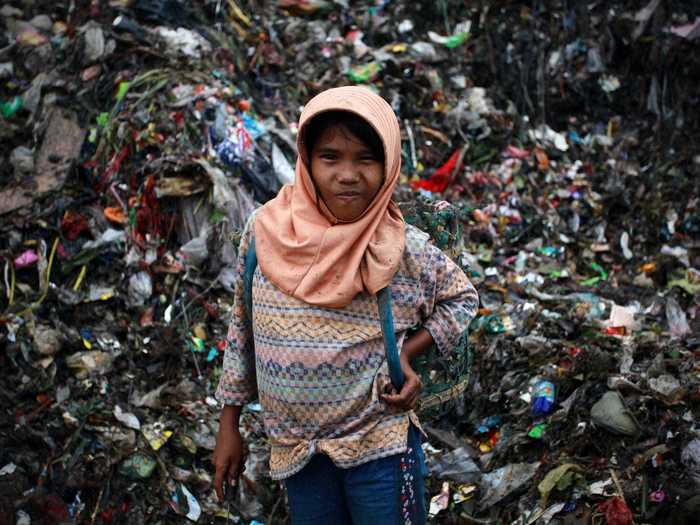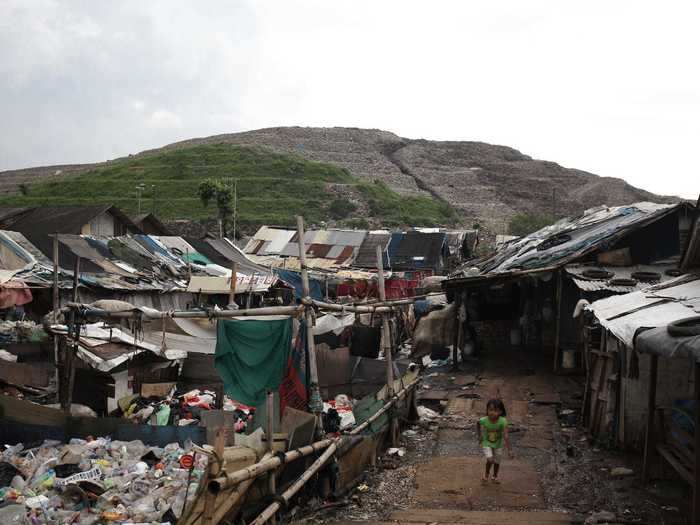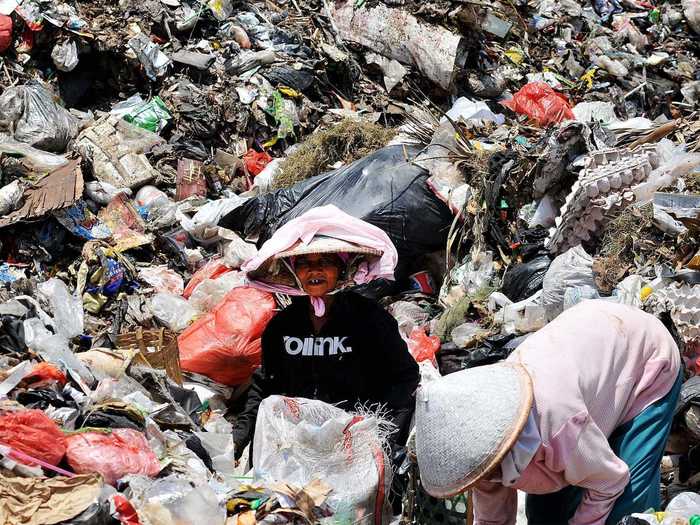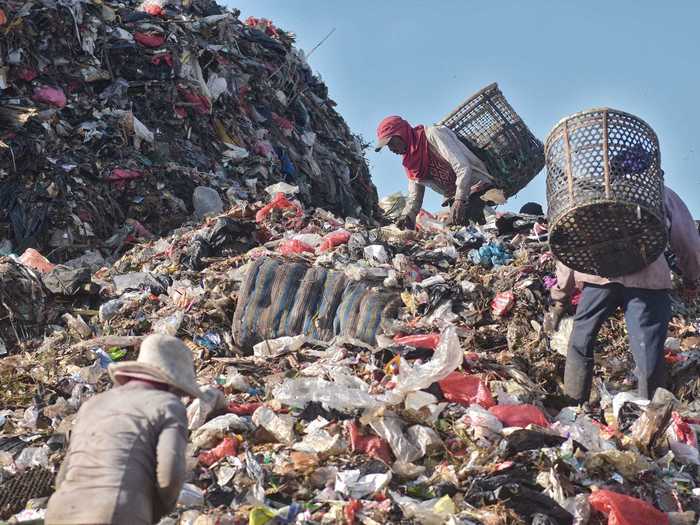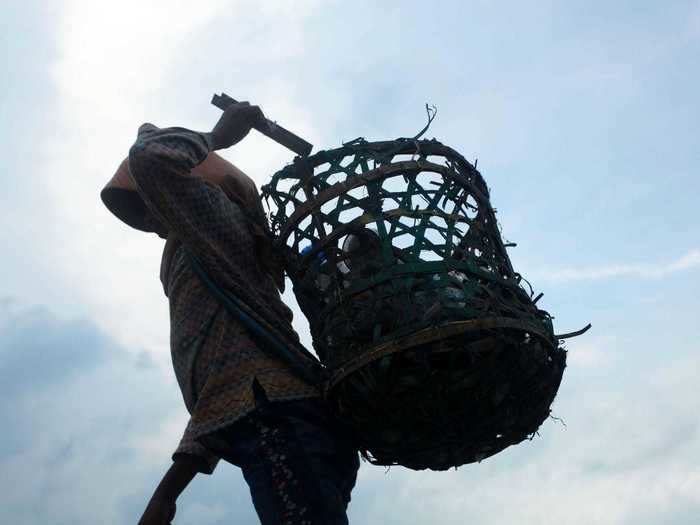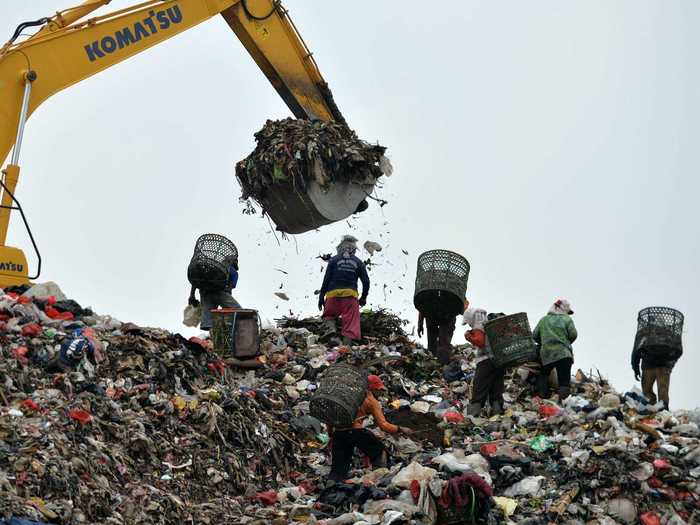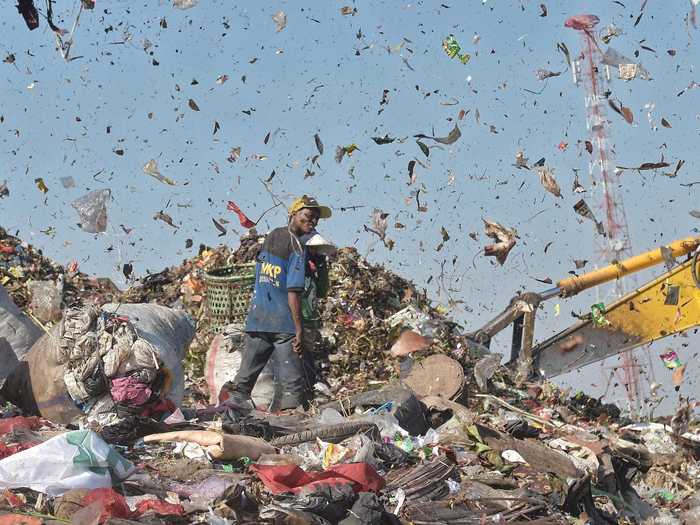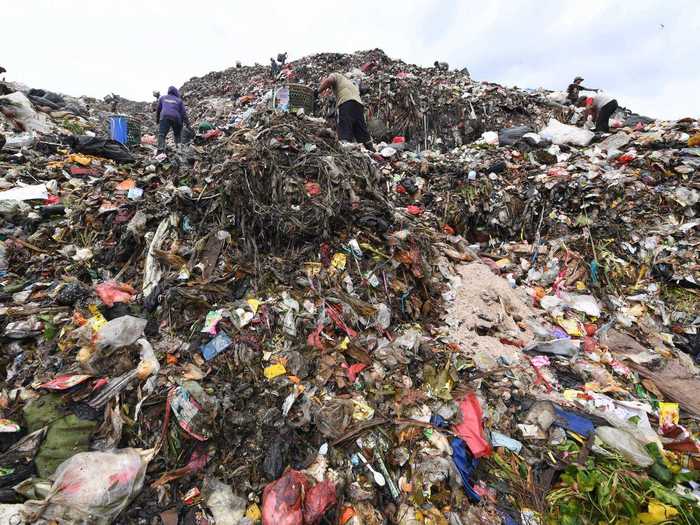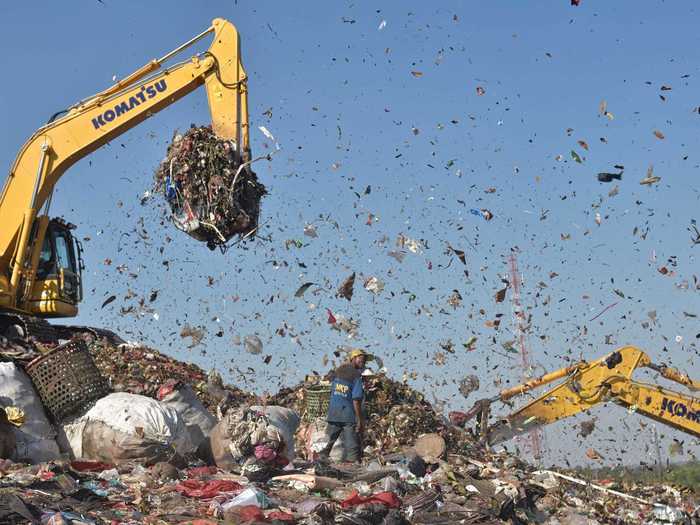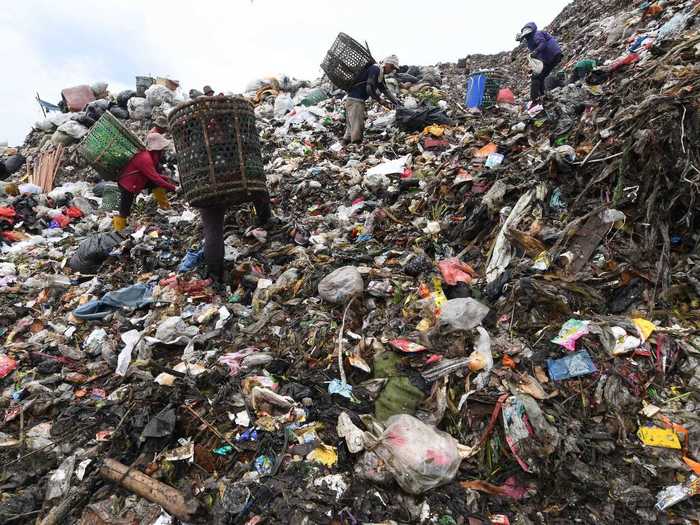Eight-year-old Basir (R), helps his sister Ning (L) to climb the mountain of rubbish where they will collect plastic, at the Bantar Gebang landfill site.Ulet Ifansasti/Getty Images
- Bantar Gebang is one of the world's largest landfills. Located outside of Jakarta, Indonesia the pile stands more than 15 stories high and 200 football fields in size.
- It accepts up to 7,000 tons of garbage every day from Jakarta and provides livelihood to thousands of poor families located around its base.
- For the past 30 years, scavengers – including children as young as five years old – have scoured through massive heaps of garbage to look for cardboard, plastic, wood, and even bones to sell.
- But the coronavirus pandemic has made their work even more difficult since many recycling companies have shut down and stopped buying scraps.
- Visit Insider's homepage for more stories.
The overwhelming stench of rotting food is just one of the many challenges that come with working on the mountain of trash at Bantar Gebang.
Scavengers are also faced with the possibility of illness, landslides, or coming too close to bulldozers dropping massive amounts of waste across the site daily.
But the thousands of families located at the base of Bantar Gebang are willing to face whatever dangers are necessary in order to collect cardboard, wood, metal, plastic, or anything else that can be recycled and sold for cash.
The scavengers, known as "pemulung," in Indonesian, typically make between $2 and $10 dollars a day, according to the New York Times.
Since the site first opened over 30 years ago in Bekasi, a city located east of Jakarta, farmers from surrounding areas and those desperate for cash transitioned their lives into working on the dump, searching at all hours of the day for items that can bring them an income.
But now, the coronavirus pandemic has threatened that livelihood, as many of the recycling companies that would pay them for scraps have closed their doors.
These harrowing photos reveal what it looks like for trash pickers living on Bantar Gebang.
Read the original article on
Insider
As of April 29, Indonesia has reported 9,771 cases of the virus and 784 deaths, with the majority located in Jakarta.
Medical officers with full outfits performed the funeral process for corpses affected by coronavirus Covid-19 in Jakarta, Indonesia on April 27, 2020
Yogi Aroon Sidabarida / Sijori Images/Barcroft Media via Getty Images
"We are telling people in Jakarta, 'please reduce your waste,'" Resa told the New York Times. "We can't process it because we can't sell it. It just makes the mountain grow higher."
Bulldozers continue to dump trash on the Bantar Gebang landfill.
Edy Susanto/SOPA Images/LightRocket via Getty Images
Even though fewer scavengers are able to work on the landfill, the trash keeps coming every day. Items that could once be sold to feed families in the villages are now being buried under heaps of new garbage.
Trash being dumped by bulldozers at the Bantar Gebang landfill.
Jefri Tarigan/Anadolu Agency/Getty Images
"People in Bantar Gebang are not really scared about this virus," Resa told the New York Times. "I don't see it has really changed their habits."
Eight-year-old Basir (R), helps his sister Ning (L) to climb the mountain of rubbish where they will collect plastic, at the Bantar Gebang landfill site
Ulet Ifansasti/Getty Images
Though many Indonesians believe that living in unsanitary environments can help to strengthen immunity for diseases like the coronavirus, the theories are unfounded and could prove dangerous for the landfill's villages.
A girl walking home from school through piles of garbage at Bantar Gebang landfill site.
Ulet Ifansasti/Getty Images
While there have been no cases of COVID-19 reported in the landfill's villages, no one has been tested for the virus either. And since most of the scavengers aren't registered as residents, they aren't eligible for government coronavirus aid.
Small structures making the scavenger village at Bantar Gebang.
Edy Susanto/SOPA Images/LightRocket via Getty Images
Additionally, social distancing guidelines in Bantar Gebang have lead to fewer people working on the mountain. "Since the virus has spread around the world, it has made life even harder now," Resa Boenard, co-founder of Seeds of Bantar Gebang, a nonprofit helping the community told the New York Times.
A scavenger sorts and collects plastics for recycling at the garbage mountain in Bantar Gebang landfill
Agung Fatma Putra/SOPA Images/LightRocket via Getty Images
But now, the coronavirus pandemic is threatening that livelihood. Many of the recycling companies that buy scraps from the trash pickers have closed their doors, leaving scavengers with far fewer places to sell.
A scavenger sorting through waste he collected from the dump area of Bantar Gebang
BAY ISMOYO/AFP via Getty Images
Despite the downsides, the promise of finding scraps has continuously attracted families, unskilled workers, poor farmers, or others desperate for cash to the mountain.
Indonesian scavengers collect plastics for recycling at Bantar Gebang, Indonesia's largest garbage dump, in Bekasi, West Java province of Indonesia, on October 10, 2014.
Jefri Tarigan/Anadolu Agency/Getty Images
Scavengers have also found themselves stigmatized or ridiculed when they travel to areas outside of the pile. One girl, who had been living near the landfill since she was six years old was called "Princess of the Dump," by her classmates because her clothes smelled like garbage.
Children pick through trash on the side of Bantar Gebang.
Ulet Ifansasti/Getty Images
The overwhelming stench of rotting garbage can also be difficult to handle. "I couldn't eat properly for weeks when I arrived, the smell was so bad," a scavenger told the Guardian after he came to work on the mountain. "I vomited every day."
Indonesian scavengers collect plastics for recycling at Bantar Gebang among goats.
Jefri Tarigan/Anadolu Agency/Getty Images
Residents have also suffered numerous health issues including skin problems, vitamin deficiencies, tuberculosis, and tapeworms. The groundwater surrounding the landfill has also been contaminated, limiting access to a clean supply.
Indonesian scavengers collect plastics for recycling at Bantar Gebang
Jefri Tarigan/Anadolu Agency/Getty Images
But working on the landfill comes with a set of risks. Scavengers are wary of the constant dangers of landslides or coming too close to the massive bulldozers dropping heaps of new garbage.
This picture taken on May 23, 2018 shows Indonesian rubbish pickers sifting through a mountain of garbage with their bare hands, at the Bantar Gebang landfi.ll
GOH CHAI HIN/AFP via Getty Images
Asep Gunawan, the head of Bantar Gebang district, told the New York Times that many children have no choice but to work on the mountain. "They have kindergarten and Quran study there, and when they finish that, they help their parents," he said.
Eight-year-old Basir stands on the landfill mountain.
Ulet Ifansasti/Getty Images
Children are not exempt from working on Bantar Gebang, either. In some cases, children as young as five years old accompany their families in search of scraps on the pile.
Eleven-year-old Nung stands on the mountain of rubbish where she will collect plastic.
Ulet Ifansasti/Getty Images
Surrounding the landfill, families live in makeshift huts fashioned out of scraps found from the mountain. A few entrepreneurs have even developed cafe-like businesses for scavengers, offering drinks, food, and cigarettes for those working.
Village of scavengers at Bantar Gebang.
Edy Susanto/SOPA Images/LightRocket via Getty Images
"I came here because the work is good and I can be my own boss," Umi, a former rice paddy farmer told the Guardian. "When you farm rice you have to wait for the harvest and the work can be backbreaking. Now I work when I want to work. There's always something to find."
Indonesian scavengers collect plastics for recycling at Bantar Gebang.
Jefri Tarigan/Anadolu Agency/Getty Images
Trash pickers typically earn between $2 and $10 dollars a day. Many of the people who work on the landfill were once farmers from surrounding areas, who found a better living cultivating garbage than rice.
Scavengers sort and collect plastics for recycling at the garbage mountain.
Agung Fatma Putra/SOPA Images/LightRocket via Getty Images
While some scavenge with their bare hands, many use a metal tool called a "ganco," which can be used to pick up items and toss them into baskets secured around their backs.
Eleven-year-old Nung, works on the mountain of rubbish collecting plastic, at the landfill.
Ulet Ifansasti/Getty Images
On a typical day, hundreds of scavengers climb the mountain in search of metal, cardboard, plastic, wood, or other recyclables. Even animal bones are a welcome find, as they can be sold to produce jewelry and other goods.
Scavengers sorting through a pile of waste at a dump area of Bantar Gebang
BAY ISMOYO/AFP via Getty Images
Trash scavengers, known as "pemulung" in Indonesian, use the massive dump of garbage as an opportunity to find scraps that can be sold and recycled for cash.
Scavengers sort and collect plastics for recycling at the garbage mountain in Bantar Gebang landfill
Agung Fatma Putra/SOPA Images/LightRocket via Getty Images
Locals refer to the massive heap of garbage as "the mountain," and since it opened over 30 years ago, numerous villages have sprung up around its base. Officials say around 6,000 people receive livelihood from the landfill, but locals estimate that number to be far higher, at 20,000.
This picture taken on May 23, 2018 shows Indonesian rubbish pickers sifting through a mountain of garbage with their bare hands, at the Bantar Gebang landfil
GOH CHAI HIN/AFP via Getty Images
The landfill stands over 15 stories high and is larger than over 200 footballs in size. Each day, up to 7,000 tons of waste enter the landfill from Jakarta.
Scavengers sort and collect plastics for recycling at the garbage mountain in the Bantar Gebang landfill.
Agung Fatma Putra/SOPA Images/LightRocket via Getty Images
Bantar Gebang, one of the world's largest landfills, is located 20 miles east of Jakarta in the Indonesian city of Bekasi.
This picture taken on May 23, 2018, shows Indonesian rubbish pickers sifting through a mountain of garbage with their bare hands at the Bantar Gebang landfill.
GOH CHAI HIN/AFP via Getty Images

